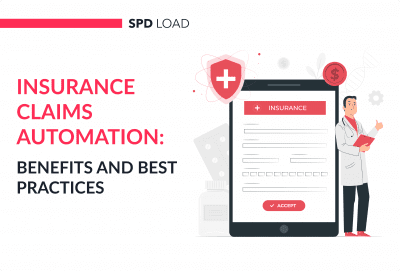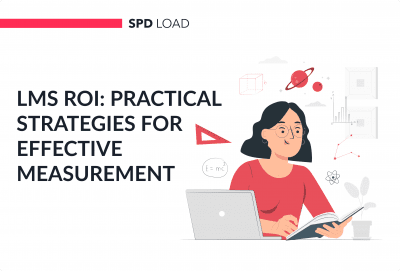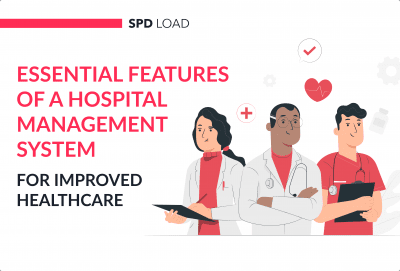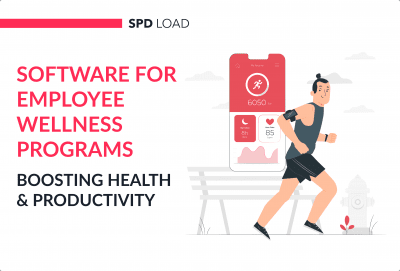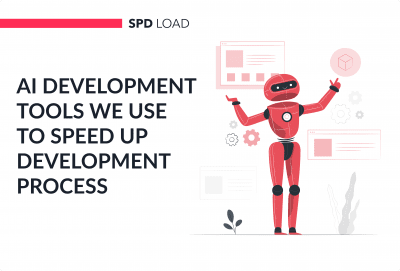Telemedicine App Development: The Ultimate Guide for 2025
- Updated: Nov 14, 2024
- 21 min
This comprehensive guide covers everything you need to know to start a successful telehealth startup.
Whether you are a seasoned entrepreneur, a product lead, or a founder, we will explore some critical design, tech, and business considerations.
Here’s what you’ll find inside:
- Why it’s a good idea to invest in this booming sector now
- The core value propositions of telemedicine apps
- Key features that are necessary to effectively serve patient and provider needs
- A step-by-step technical build and launch process
- Budgeting development costs
- Tips for vetting and picking the right dev team
Are you ready to build the next game-changing platform?
Explore the potential of healthcare app ideas to make a meaningful impact in healthcare.
Let’s get started!
For first-time founders, these business startup tips can make all the difference.
Unlock your startup potential now — start transforming your vision into a scalable solution with our expert developers today!
Why Telemedicine Startups Are Booming Now
The current situation favors a telemedicine startup in the United States. Market trends provide a fantastic opportunity to invest.
There are two factors influencing the rising popularity of developing a telemedicine app.
1. Pandemic Fueling Demand
- Due to the COVID pandemic, the number of telemedicine users, both patients, and medical professionals, increased by 100 times.
- According to Statista, 60 to 75 percent of US adults are willing to use the telemedicine app in their daily life.
- 70% of users are entirely happy with the service offered by TM services. They intend to use these again in the foreseeable future.
When technology becomes mundane, the creation of a new product is a predictable consequence. But in a growing market, there is always room for a new product.
Changing behavioral patterns due to a pandemic is the first reason to invest in developing a telemedicine app.
Let’s look at one more. 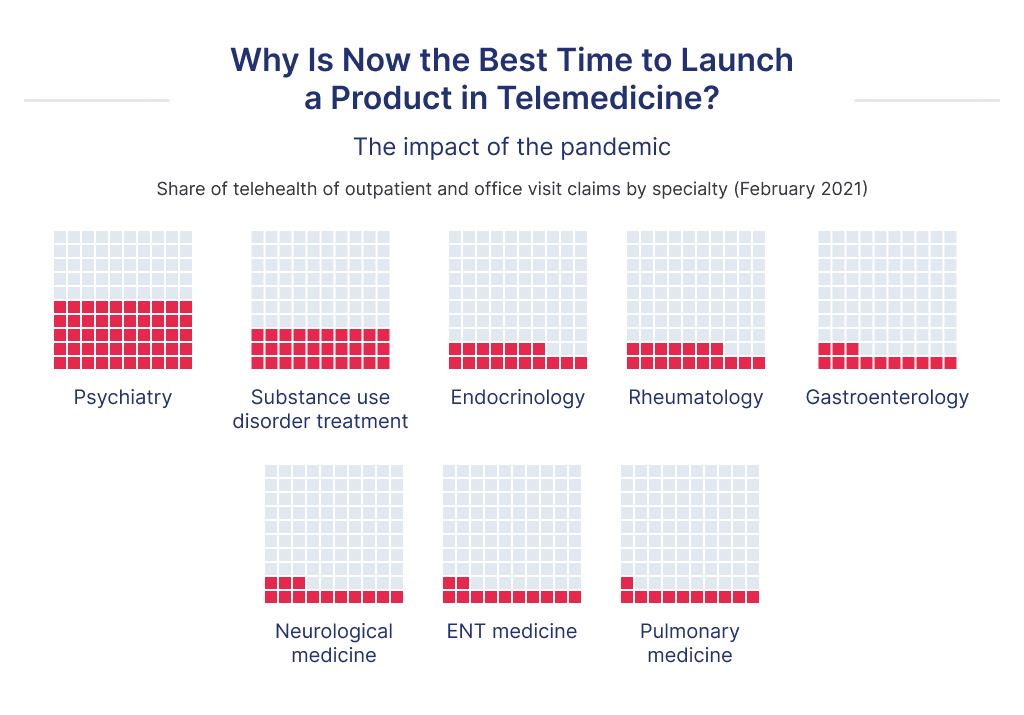
2. Venture Investment Explosion
- By 2026, the telemedicine market’s value may increase to $175,5 billion.
- According to Data Breach market research, the telehealth sector will increase at a CAGR of 22.67%
- According to recent research, 83% of healthcare companies plan to invest in telehealth. 84% believe that they can expand their reach and cover more areas.
These statistics indicate a boom in the telemedicine application development market. And behind every boom is venture capital investment.
We conclude that this is a market that is booming due to behavioral shifts and tremendous investment potential.
We hope you agree with the statistics, too, and don’t just trust your senses. Although both are great complements when you’re thinking through the value of your future startup.
Let’s talk more about it. 
Benefits of Telemedicine Apps
There are a plethora of benefits for using and developing healthcare applications. Especially telemedicine apps both for doctors and patients. Some of the benefits are as below:
For Patients
| Benefit | Description |
| Faster Solutions | These HIPAA-compliant texting apps are of great use when a patient is suffering from minor health issues like cold or fever. They can connect with the doctor with the mobile and get the right medicine in a couple of minutes. This saves the time of travel and waiting in the doctor’s office. |
| More Convenient | Providing convenience to the patients is the sole purpose of the telehealth application. You do not have to waste your energy traveling while you are sick. You can call your doctor to get the right medicine. And that’s the main reasoning to start the development. You get the official paperwork right on the app, saving your efforts to roam in the hospital to get it done. |
| Easy Access to Specialists | The hospital in your town or the nearby area might not have all kinds of specialists available. So you may have to go to a faraway location for getting the treatment done for some particular disease. Using these apps, you get to consult any kind of specialist you wish to see. And this is one of the crucial reasons for the telehealth app to start development in 2021. |
| Better Satisfaction | One of the biggest advantages of using telemedicine applications is that you get full satisfaction. You can have a healthier conversation with the doctor and can clear all your doubts. Most telemedicine apps give you a 24/7 service. So whenever a question arises in your mind, you can go to your account and get it cleared. |
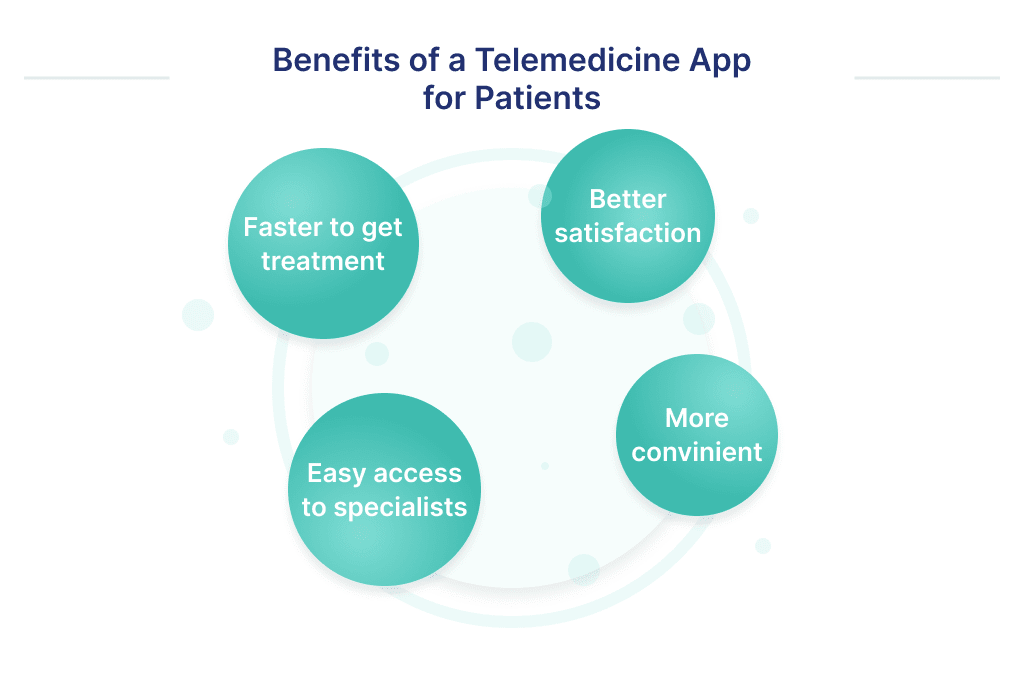
For Doctors
| Benefit | Description |
| Efficient Monitoring System | Telehealth applications should include an effective monitoring system. Such software keeps a record of all medical history of the patient, and doctors can hire a virtual scribe to take detailed notes of each visit as well. Thus, it’s an important part of development. All the previous medical records are available by date, which helps the doctor to follow up. |
| Extensive Patient Reach | As doctors, especially specialists, are not available in every corner of the country. So the application helps the doctor to reach outlands and serve the patients there. |
| Better Practice Efficiency | As the product holds the record for every little detail of the patient, it enhances the decision-making of the doctor. The doctor is able to serve more patients as the physical commutation of the patient is not there. |
| Time-Saving | As the basic process in the software is automated, thus the doctor can save time on basic past-related queries. The app itself shares the data with the doctor at the start of the session. |
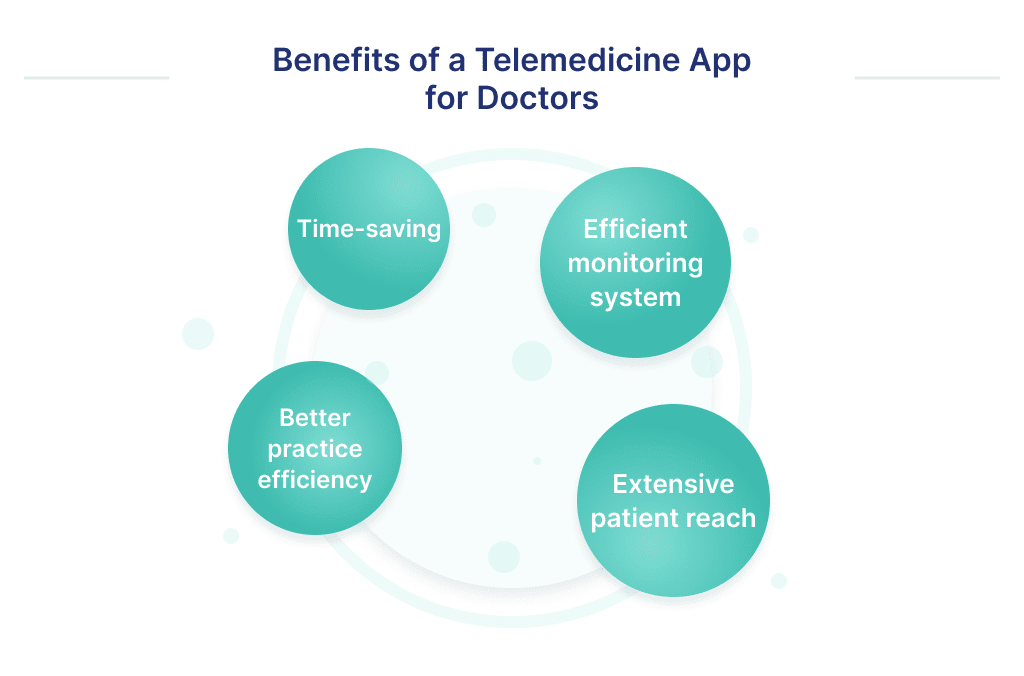
All these features are a must for developing a telemedicine app, hence pay attention to these points while research how to make such kind of software.
They provide the best healthcare app design and technical solutions to improve the value offer of a product.
Telemedicine App Development Costs
The telemedicine app development cost varies from $75,000 to $250,000.
The price depends on a number of factors including the type of application, its complexity, the kind of team, its technical level, and location.
We’ll consider 3 pricing options based on the type of application, the type of the team, and the location of the team.
As an example to calculate, let’s take the price for an MVP development that takes 1,500 development hours.
Costs by App Type
There are 3 main types of telemedicine applications: asynchronous or store-and-forward, remote monitoring, and real-time interactive.
Let’s take them as a basis to figure out the cost of developing a telemedicine application depending on the type.
| Type of a telemedicine app | Average cost, $ | Example |
| Store-and-forward | 40,000 | CirrusMD |
| Remote monitoring | 55,000 | Gyant |
| Real-time interactive | 75,000 | Lemonaid |
Another crucial pricing factor is a type of a team.
Costs by Team Type
We’ll take a look at the most popular types of teams, assuming the telemedicine app development project is done under one roof from start to finish.
| Type | Average cost, $ |
| In-house team | 170,000 |
| Local development agency | 250,000 |
| Freelancers | 38,000 |
| Outsourcing development agency | 75,000 |
In addition to this table, you can find out or compare prices using our app development price calculator or developer salary calculator.
For trusted IT partners, explore the best IT outsourcing companies listed here.
Now, let’s find out how location affects the price of developing a telehealth app.
Costs by Team Location
We look at the most relevant regions for launching startups or outsourcing app development.
| Location | Average cost, $ |
| Australia | 160,000 |
| The USA | 280,000 |
| The UK | 180,000 |
| Western Europe | 150,000 |
| Eastern Europe | 75,000 |
| South Asia | 45,000 |
In addition, there are 2 other budget items for a startup: app marketing and app maintenance.
App marketing will cost two or three times the telemedicine app development budget. At the same time, app maintenance will cost 25% of the original development budget.
We’ve looked at pricing options. Let’s move forward to the development process of a telemedicine software product. 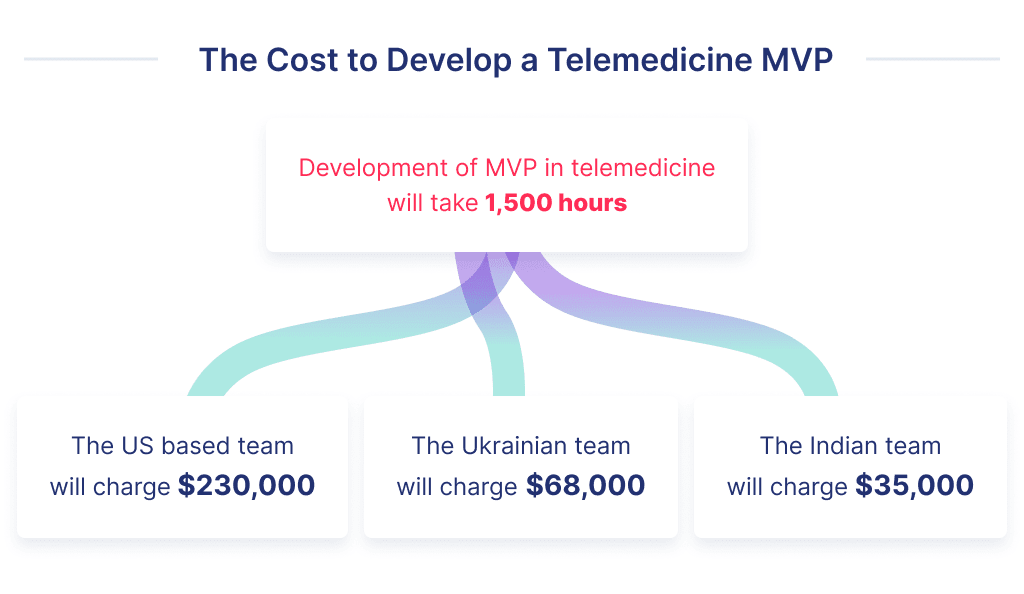
Building a Telemedicine Biz
Discovery Research
To provide the right telemedicine app development solution, a project discovery phase plays a crucial role. This phase includes a series of steps. And starts with collecting and analyzing all the required information about the project.
It’s a fundamental stage of project planning. It gives clarity on how to develop required features according to market and customer expectations of a telemedicine app.
With a detail-orientated research process, an SRS (System Requirements Specification) document is generated that consists of all the requirements of your application building.
From features to resources to the interface, all things are covered in a simplistic and detailed form in this document that helps in telemedicine app development.
Empower your practice with custom EHR/EMR solutions tailored just for you.
It is implemented by following the idea validation approach. It determines the challenges, complexities, and compatibility of the project based on various observations.
This phase can take from one week to a month depending upon the complexity you require in the application.
The development essentialities you will get in this phase for a telehealth app are:
- All the specifications required for telehealth app development.
- The project goals, technology stack needed for building it, architecture, and the features of the application.
- A digital interface prototype will be developed by the telemedicine app developers.
- It will show a basic design for the application you are aiming for.
- The discovery phase will also include the MVP, how to make plans, timeline requirements, and the total budget required for the telemedicine app.
- Learn everything about how to launch an MVP successfully.
The discovery phase helps in eliminating the uncertainties of the project. As the execution of the process is deeply looked upon, thus the risk of missing the deadlines gets reduced by over 70%.
Also, the team gets an established road with a clear set of goals to work on. More importantly, this builds a great trust factor between the telemedicine app developers and the owners. 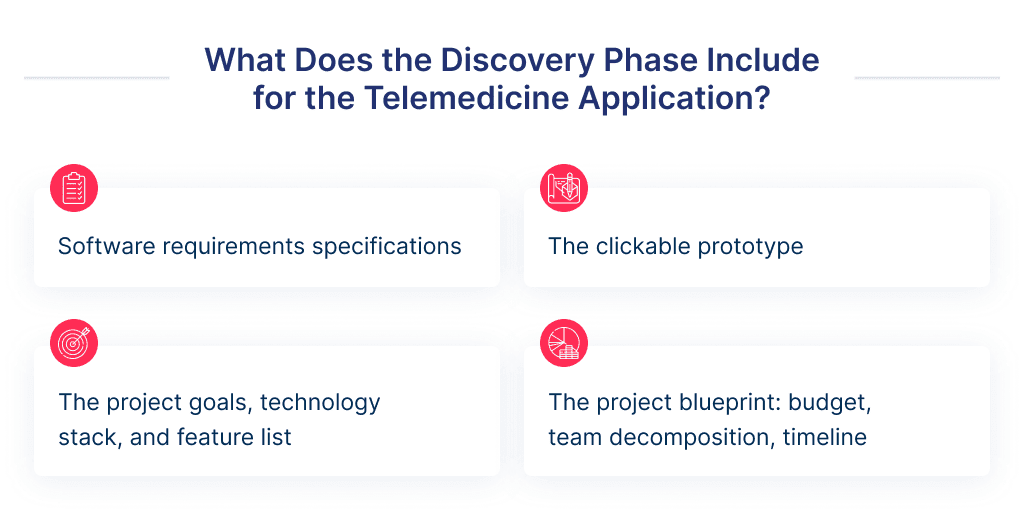
Revenue Models
There are several models that are required for how to develop a telemedicine app in order to generate revenue from the usage.
These models need to be thoroughly planned and strategized by the telemedicine app developers before they go ahead with the development process.
The basic way through which these apps earn a profit is through the fees. For instance, Doctor on Demand charges a fee of 25% from the patient for every successful appointment they make with the doctor.
The scalable business model is crucial for your product growth. Yet, the developers also should know what is your plan of monetization for a better technical design of your telemedicine app.
However, the thoughts of scalability are a major factor in general to consider, when you think about the cost of the app design stage.
It is estimated that Doctor on Demand made revenue of 12 million dollars in the previous year.
So to understand how to develop a telemedicine app and make money through it, let’s go ahead and study the models in detail.
| Model | Description |
| Subscription Model | One of the basic ways through which telemedicine apps make money is through monthly or annual payment plans. The patient and the doctor both need to pay a certain amount of fee for using the software. You can either create a membership plan on an annual or quarterly basis and give them discounts to enroll in them. This is a good way to ensure a more user base for your software program. It must be considered while you develop a telehealth app. |
| Advertisement Model | In-app advertisements are the best way to generate high profits from your application. Advertisements generate a good economy and as well as a solution for the telemedicine app development. Various advertisers are looking for presenting their ads on platforms with a large group of people. For that, they pay you a good deal of money. Yet, playing advertisements excessively results in losing the user base, so you need to keep it minimum. The business development department must make sure on how to develop a scalable advertisement model for a telemedicine app. |
| Reference Model | Another way to earn money for telemedicine apps is through references. Though this model will not pay you initially but can generate good value at later stages. As your product becomes popular, there will be more users and doctors wishing to join the app. For every reference for a patient or a doctor to join the app through reference, a certain fee is charged. |
| Franchising Model | The sole purpose of building a telehealth app is that you can get medical services without physically going to the hospital. This amazing concept is highly workable across the globe. So, to earn more from your app, you can distribute it overseas as a franchise. SkyHealth, a well-known telemedicine application, does the same. It charges $3000 for selling its franchise to healthcare organizations. |
The above-given models are the best way to ensure the right process for how to make a profitable healthcare software or telemedicine app.
Staying competitive in healthcare means innovating. Here’s how to win the technology race in the healthcare industry. 
Outsourcing can streamline your app development. Here’s a complete guide on finding the right mobile app developers.
Telemedicine App Technical Build
Building a telemedicine app requires good timing, right planning, and execution. Below given pointers will explain the steps of how to develop a telemedicine app.
Crafting an MVP
Certain features of a telemedicine app are self-evident, such as the live video chat functionality mentioned earlier.
Others work in the background to keep everything in harmony, yet the founder can add more sophisticated functions to improve the user experience. However, it could significantly impact the cost of MVP development.
It can be a complex task to add a feature in the current iteration that wasn’t a part of the early planning stage, especially if the team didn’t build the MVP with it in mind.
As a result, it’s critical to compile a list of all core features and functions. Whether they are simple or sophisticated, one has to do this ahead of iteration starts.
The major problem in developing efficient telemedicine software is simple. It is integrating these component elements thoughtfully and effectively.
It is to create a solution that is secure, easy to use, and massively available.
Make a list of all the features of your telemedicine app that you consider essential. These are the features that the application would not work without. In the initial development process, one must address these issues.
There is a list of required features and technical solutions, that must be in your MVP.
| Feature | Description |
| Database Design | Telemedicine app development has a huge requirement for the storage of data. From prescriptions to reports to the medical history of the patient, all are stored in a database. Thus, a reliable database platform caters to this need for the platform. So the technology companies like MongoDB or Redis provide a platform integration with the software where you can store all your files. However, it is not a fairly simple process. There are various sets of standards and norms that are to be considered for successfully implementing it. So the telemedicine app developers use the SSL protocols for data exchange from the app to a database that keeps the data secure from hackers. |
| Security Module | The biggest challenge for a developers team is fulfilling the security norms of the healthcare authorities for telemedicine apps. To ensure the app is HIPAA and GDPR compliant, and the patient data is secure, we use different encryption solutions like Laravel Encryption. There are various protocols used that make the data of telemedicine apps safe from breaches and secure from hackers. So to develop such a platform that is efficient. |
| High Load User Flow | There are several instances when the app is loaded with plenty of users that may lead to the crashing of the app on the server. So the developers of the telemedicine app foresee this problem and maintain the database with such efficiency using automatic scalability tools that this problem doesn’t arrive. Each storage bit is stored in a way that when a high load of the user comes, the backup files are stacked below so that the required information can be generated quickly. Get a clear picture of the cost of hiring a software developer to budget for your next project. |

Sticking to the MVP strategy prevents quality problems. It also guarantees that you stay on track with the time and budget assumptions you set at the start of the project.
Explore the best practices to grow your MVP into a sustainable product in this guide from MVP to full-scale product.
The telemedicine application has 3 versions of the app. So both these panels have different features according to their requirements.
So down below are given the most crucial features of both versions of the telemedicine app.
1. Features for the Patient’s Mobile App
Let us look at the features that tell us how to develop a telemedicine app and make it into a success.
| Feature | Description |
| User Profile | The user will register through their profiles. |
| Geolocation | For enlisting hospitals and pharmacies in your surroundings. |
| Medical Records | Maintaining your entire medical history. |
| Communication Ways | Doctors can connect through in-app chat, in-app calls, or video sessions. |
| Doctor Reviews | To check which doctor to consult. |
| Payment Gateways | For safe and secure fee transactions. |
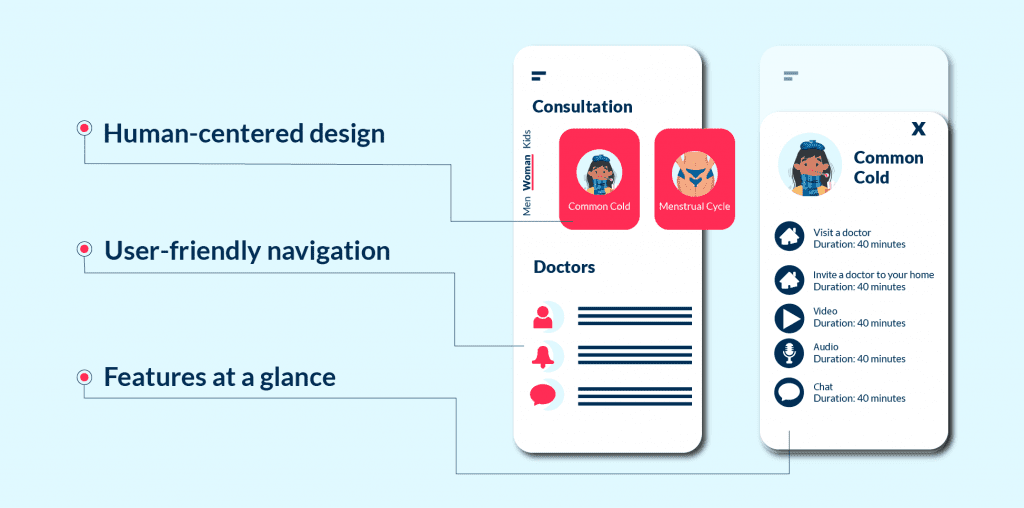
2. Features for the Doctor’s Web App
There are applications for doctors in the field of telemedicine. Some services suggest using a mobile app, but we’ll look at the option of developing a healthcare website.
| Feature | Description |
| Doctor Profile | The doctor will register and provide their information. |
| Managing Appointments | To see and manage their appointment list. |
| Scheduling | To alter their schedule and availability. |
| Medical Records | For accessing the patient’s medical history. |
| Communication Medium | Connect with the patients with in-app chat, in-app calls, or video sessions. |
| Prescriptions | For prescribing the medicines to patients. |
| Payment Management | To manage the payment and account of the patient fees. |

3. Features for the Admin’s Web App
You can control all operations throughout your app with a telemedicine admin panel.
It gives you access to your customer’s accounts and other data needed. You can also access all the monetization tools you need.
The following functionalities should be available in your admin panel:
| Features | Description |
| Personal profiles management | On the admin side, each admin must have a profile. You’ll be able to track who made modifications. You can set different levels of access. This can safeguard data and maintain control over specific features. |
| Doctor profiles Management | An administrator will be able to access and manage doctors’ profiles. One can access this from the app’s admin panel. With these features, one can gain access to all physician’s previous phases. They can cancel an identity if a doctor breaches regulations. Altering data in a doctor’s profile is also possible at a service center’s demand. |
| Patient Profiles Management | Like doctors, an administrator has to be able to access data. They must be able to change the information in patient profiles. It includes being able to see their medical records, financial history, activity, and so on. |
| Analytics | You can always understand what’s happening with the application. It is possible with insights in the admin panel. From a brand and sales perspective to the number of users who have installed the app. This also includes users that have joined the program. Here’s everything you need to know about building a brand from scratch, from concept to execution. |
| Notifications Management | With this tool, patients and doctors can quickly receive automatic updates. Relevant dates, policy updates, promotional deals, and more are accessible. One can classify individuals based on their actions, geography, or other factors. This can help with more personalized alerts. |
| EHR System Integration | Connect the app’s admin panel to an electronic health records system. It will allow administrators to see the most recent changes to a patient’s medical data. This will help in case there are any issues or concerns. Explore the benefits of electronic health records and why they’re essential for modern healthcare. Wondering how to build EHR/EMR software? Our expert guide walks you through the essential process of developing secure health tech solutions. |
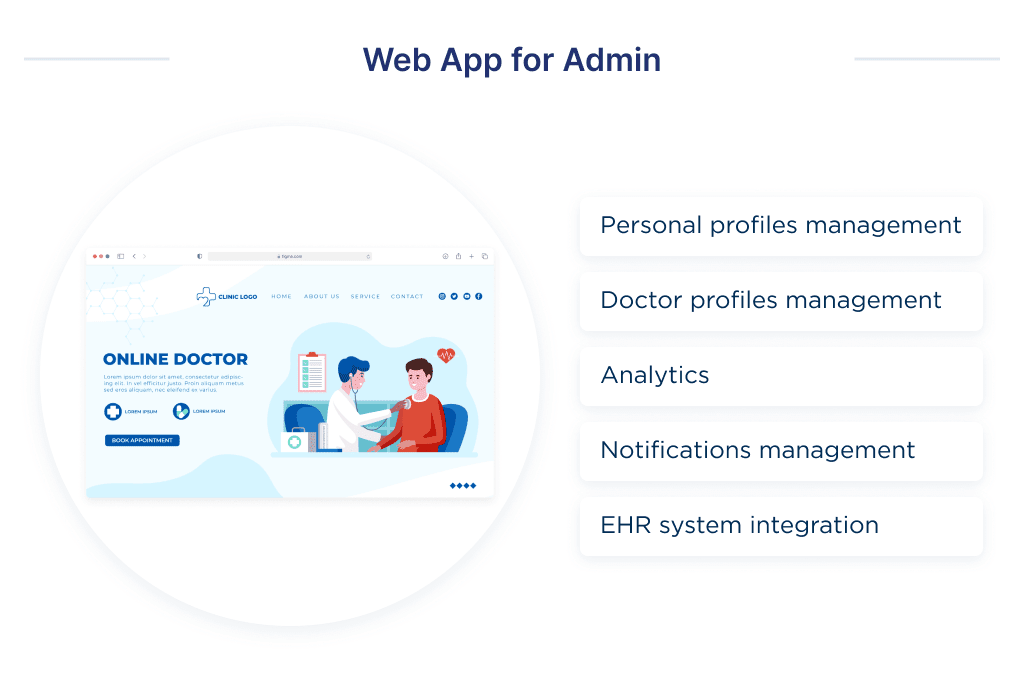
Key Tech Stack Components
| Type of technology | Our stack | Description |
| Backend Framework: | Laravel | Laravel is the best PHP framework. It has a very powerful environment with plenty of ready-made integrations. The main benefits are making routine tasks automated like routing, authentication, sessions, and caching. |
| Frontend Framework: | React, React Native | React and React Native is a technology that significantly decreases development efforts. It helps to scale the team faster. React-based apps are faster and smoother work. And they require less use of apparat memory. |
| Push Notifications and Phone or SMS Verification: | Twilio | It is a development-driven tool for communications. Software teams use APIs to add capabilities like voice, video, and messaging. This enables your startup or company to provide a great experience for customers. If you are thinking of creating a brand new messaging solution, check out this guide on how to create a messaging app step by step. |
| Payments: | PayPal, Stripe | Different payment gateways offer different terms of cooperation. Thus, this choice is based on particular requirements for a product. For example, PayPal doesn’t support some countries. |
| Database: | Hbase, MongoDB, Postgres, Cassandra | As well as with payment gateways, the choice of database and environment is based on the particular requirements for the product. Because each of these tools provides their own benefits for a particular case. |
| Cloud Environment: | GoogleCloud or AWS |
Challenges in Telehealth App Development
Telemedicine app development is not a cakewalk and demands high expertise and plenty of time to get it done. The efficient development process always makes your own telemedicine app stay one step ahead of others.
We are empowering healthcare innovation through custom apps
Some of the biggest challenges are as follows:
1. Implementation of UI/UX
| Description | Solution |
| Implementing the UI/UX requires creating an innovative app that can work well on all different platforms. The biggest challenge that telemedicine app developers face is to create an interface that meets the demand of all sets of users. For instance, what a doctor wants on the screen, might not be relevant for the patient. And vice versa. | So here’s how a team of developers deal with it while making your own telemedicine application:
|
So when a developer is comprehending how to develop a telemedicine app, the important thing they must consider is user experience and interaction with the application interface.
2. Backend Integration
| Description | Solution |
| Backend Integration ensures quick and successful data transfer from the patient’s end to the doctor’s end. Though the implementation of this process is a lot more challenging. Telemedicine app development requires the integration of many features in the app that must be HIPPA compliant. Also, there are many third-party services developers need to include for the payment, locations, and other aspects. | To install these in the telemedicine app:
|
To provide the right telemedicine app development solution, a good and robust backend process must be there. It helps to create a uniform data transaction between the doctor and patient.
3. Scalability
| Description | Solution |
| An excellent telemedicine app development solution requires many features for its successful implementation. One challenge that most telemedicine app developers ignore is the scalability of the application. As the app becomes popular, the demand and the user base take an unexpected spike. If the development team isn’t ready to take such a load and it becomes a challenge to cope up with the situation. | There is a way to upgrade your telemedicine app before:
|
4. Compliance with Healthcare Authorities
One of the biggest challenges to develop a telemedicine app is making it compliant with HIPAA and GDPR.
| Description | Solution |
| There is a set of standards set by the HIPAA (Health Insurance Portability and Accountability Act) to consider while making the app. These protocols aim at the protection of the medical records of a patient. | The biggest concern that developers face is embedding these rules with the features of your telemedicine app. Thus, HIPAA compliant app development includes:
|
The development is only complete when the data on your telehealth app is HIPPA compliant. It prevents data breaches and makes the data exchange more reliable.
Furthermore, it provides the needed telemedicine app development solution.
5. Data Security
The security of the data is important. Most software stores their data and access it from the cloud servers. If the backend infrastructure is weak and lacks security, it won’t take much time for hackers to breach the data.
And that’s the main reason why coders pay so much attention to database design during telemedicine app creation.
| Description | Solution |
| The most prominent challenges in providing security to the application are cross-site scripting. While broken authentication, session management, and exploitation of sensitive data are also tough. The backend team has to be experienced enough to know how to develop a HIPAA-compliant telemedicine app at the highest level of security. | So to provide better security in the telehealth app development process, the following aspects should be kept in mind:
|
Using the secure API frameworks and libraries, you ensure that your telemedicine app development process is safe and secure. 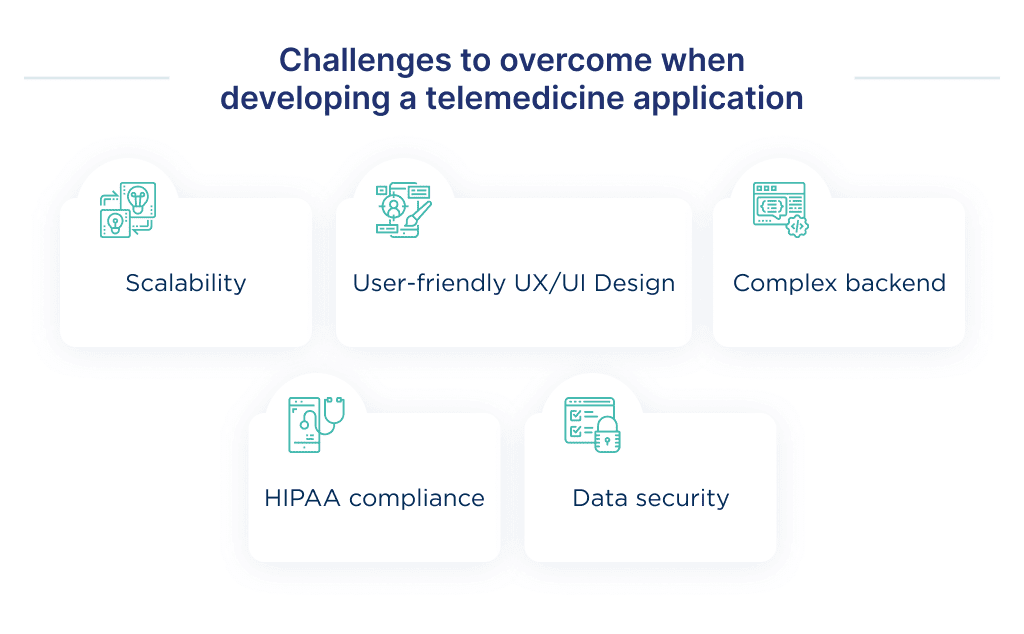
Launching Your Telehealth App
The launch process is initiated once your project requirements get the desired telemedicine app development solution. However this is not the end of the projects and in a way, is just the beginning.
The best approach to make your application a big success is following the Lean Startup Methodology. It aims at the approach of build, measure, and learn.
It gives useful insights on how to develop the next features effectively for your own telemedicine app.
The following approach makes your application better and more productive.
- Once the MVP application is in the marketplace, the user feedback is collected.
- Analyze the given feedback and work on features that have negative reviews.
- Also, focus on the new features that are feeling missed by the users and make them with the high initial value.
- This will build more user engagement.
- Remember the application has made its way in the market so users will need appropriate tools for fast A/B testing.
- Add on new features within a month’s time so that the user keeps their interest in the app and does not move to some other app.
- Go back to step one and follow the same procedure to add more features for making the application more efficient.
All these steps ensure great efficiency while developing a telehealth application. 
Our Expertise in Building Telehealth Apps
Here, at SpdLoad, we focus on delivering the best quality products for healthcare startups. We have deep expertise in building HIPAA compliance telemedicine applications.
We know the following challenges and know how to beat them in an efficient way.
Let’s take a look at our case on developing the telemedicine app from scratch.
The team composition includes:
- 1 Business Analyst
- 1 UX/UI designer
- 1 Backend developer
- 1 Frontend developer
- 1 Mobile developer
- 1 QA tester
- 1 Project Manager
And here is how we did it:
- The customer came to us without specific requirements. The task was to build a market-driven telemedicine application.
- The main challenge was to identify the target audience, find relevant pain points, and offer a valuable solution. Thus, we start the development:
- We start with an in-depth market analysis. We generated a set of hypotheses to check in 3 fields: what pains are we gonna solve? Why would customers use our application instead of current solutions? How to make our offer better than existing?
- Afterward, we continue to work with design researchers. It helped us to create customer personas and user journey maps. It was a start point to clearly offer the core values of our product.
- As a result of customer development, we created a customer and market-driven set of requirements to start an MVP development.
- The main technical challenge was to make the application HIPAA compliant. Yet, our expertise helped us to manage that part in 100 development hours.
There is an estimation of the MVP we built from scratch. It includes a mobile app for patients and a desktop one for doctors and admin.
| Type of task | Time to implement |
| Business Analysis | 60 |
| UX/UI Design | 120 |
| Backend Development | 350 |
| Frontend Development | 800 |
| Quality Testing | 300 |
| Project Management | 250 |
| Total | 1,880 |
The following stage of MVP development services includes the development of:
- Mobile application and web platforms
- HIPAA Compliance
- Set of different roles: Patient, Doctor, and Administrator
- Integration of payment gateways
- Secure chat and video calls
This is the approximate time required for an MVP. However, it consists of only basic features that are a must in the app.
As we consider more complex features and technologies, the time taken gets increased. Also, the cost to develop the telemedicine app is rising.
Next Steps
Starting a telemedicine startup can be complicated, but it has tremendous potential for growth and success.
Before jumping in, it’s crucial to understand the user’s needs, technical considerations, and growth opportunities in the field. Research is critical to aligning your solution and strategy with the market.
Once you have a good understanding of the key development challenges and roadmap ahead, it’s time to take action!
If you need an experienced UX/UI design partner to help create an intuitive, user-friendly telemedicine experience, our team is here to help.
We combine empathy, research, and best practices to design telehealth platforms that address patient and provider pain points at every step.
Let’s connect and explore how human-centered design can help your app scale and stand out!
Thinking of building an EMR? Here’s a comprehensive EMR systems development guide to get started.
Picking the right partner is crucial — here’s how to choose an app development company that fits your needs.




